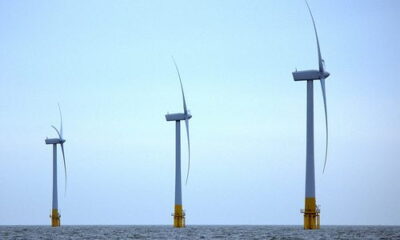

Energy
Floating offshore wind: potential to deliver cost effective, secure low carbon energy
Floating offshore wind has the potential to deliver cost effective, secure and safe low carbon energy for the UK from the mid 2020s according to the latest insights report published by the Energy Technologies Institute (ETI).
With continued technology and supply chain development there is a clear and credible route to delivering commercial offshore wind farms.
Analysis carried out by the ETI suggests that floating wind technology has the potential to deliver a levelised cost of energy of less than £85/MWh from the mid-2020s, allowing it to compete with the lowest cost forms of low carbon generation.
The UK already has the world’s highest offshore wind capacity and in order to reduce costs further, there needs to be access to good quality wind resource, which is close enough to the shore and power users so that transmission costs are minimised and operations and maintenance costs reduced.
Floating offshore wind technology can open up new commercially exploitable sites in deeper water relatively close to the shore which are currently inaccessible due to limitations in the depth to which fixed foundations can be deployed.
The Floating Wind Technology Insight uses evidence from the ETI’s Energy System Modelling Environment (ESME) tool, an internationally peer-reviewed national energy system design and planning capability, together with the findings from the ETI’s £62m Offshore Wind Programme.
The ETI sees the development and deployment of floating offshore wind technology as a key strategic issue for the UK to address and this will require investment in full scale technology demonstrators and the availability of suitable test sites.
Stuart Bradley, Strategy Manager, Offshore Renewables at the ETI and the report’s author said: “UK wind resources are abundant and are already being exploited, with the country having the world’s highest offshore wind capacity. Developing floating technology can provide access to additional high quality wind resources in deeper waters, relatively close to the UK shoreline and near centres of population which will help bring costs down further.
“In water depths of less than 30m traditional fixed foundations will be the prime solution, but, in water depths over 50m floating foundations provide the lowest cost solution so a mix of these technologies is likely to offer the lowest cost pathway to deliver mass deployment in UK waters.”
“Floating foundations are still some way from large scale deployment and the offshore wind industry is currently focussed on delivering the Round 3 sites in shallower waters.”
“At this stage there is little, if any, market pull for floating wind solutions and technology push will be needed until deeper water sites are provided so test sites and policies need to be in place to encourage the development of floating technology suitable for UK waters if it is to be available by the 2020s.”
More details on the Floating Wind Technology Insight, including the report, video and infographics are available here.


 Environment10 months ago
Environment10 months agoAre Polymer Banknotes: an Eco-Friendly Trend or a Groundswell?

 Environment12 months ago
Environment12 months agoEco-Friendly Home Improvements: Top 7 Upgrades for 2025

 Features9 months ago
Features9 months agoEco-Friendly Cryptocurrencies: Sustainable Investment Choices

 Features11 months ago
Features11 months agoEco-Friendly Crypto Traders Must Find the Right Exchange





























